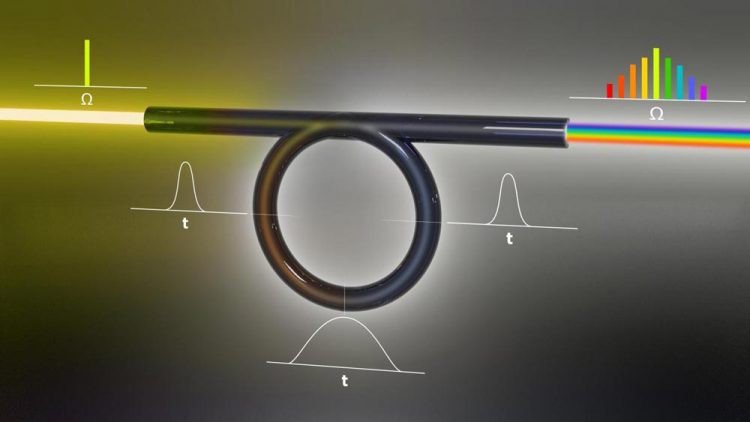Project creates more powerful, versatile ultrafast laser pulse

In the stretched-pulse soliton Kerr resonator developed by the lab of William Renninger, a single frequency laser enters a fiber ring cavity, generating a broad bandwidth comb of frequencies at the output that supports ultrashort femtosecond pulses. Inside the fiber cavity the pulses stretch and compress in time, reaching a minimum duration twice in the cavity near the center of each of the two fiber sections. The stretching and compressing temporal evolution is a salient characteristic of femtosecond stretched-pulse soliton Kerr resonators. Credit: Illustration by Michael Osadciw/University of Rochester
University of Rochester researchers are setting a new standard when it comes to producing ultrafast laser pulses over a broader range of wavelengths than traditional laser sources.
In work published in Physical Review Letters, William Renninger, an assistant professor of optics, along with members of his lab, describe a new device, called the “stretched-pulse soliton Kerr resonator,” that enhances the performance of ultrafast laser pulses. The work has important implications for a range of engineering and biomedical applications, including spectroscopy, frequency synthesis, distance ranging, pulse generation, and others.
The device creates an ultrafast laser pulse–on the order of femtoseconds, or one quadrillionth of a second–that's freed from the physical limits endemic to sources of laser light–what laser scientists call laser gain–and the limits of the sources' wavelengths.
“Simply put, this is the shortest pulse ever from a gain-free fiber source,” Renninger says.
Renninger and his team of graduate research and postdoctoral associates improved upon Kerr resonators, an exciting new alternative for generating femtosecond laser pulses that have been the subject of considerable research.
The lab overcame a challenge to pulse duration in other versions of Kerr resonators by discovering a new soliton–a short burst or localized envelope of a wave–that maintains its shape while propagating at a constant velocity. The solitons generated in Renninger's device differ from the solitons in other Kerr resonators, specifically in the shape and behavior of the stretching pulses they create.
“It is stable in the sense it keeps repeating the same thing over and over, getting longer, then shorter, longer then shorter,” Renninger says.
The pulses “feature a broad spectral bandwidth and a compressed pulse duration of 210 femtoseconds, which is the shortest pulse duration observed to date from fiber Kerr resonators,” the researchers state in the paper.
Lead author Xue Dong is a graduate research associate in the Renninger lab. In addition to Renninger, other coauthors are Qian Yang and Christopher Spiess, also graduate research associates in the lab, and Victor Bucklew, a former postdoctoral associate in the lab.
The study was funded by in part by the University's Technology Development Fund, a University Research Award, and by the National Institutes of Health. A patent is pending. Interested parties can contact Curtis Broadbent, licensing manager at URVentures, about licensing the technology.
Making ultrafast lasers more accessible
Renninger, an expert in creating sources for femtosecond lasers, received his BS and PhD degrees in applied physics from Cornell University. Before joining the Institute of Optics, he was a postdoctoral associate and an associate research scientist in the Department of Applied Physics at Yale University.
He recently received a National Science Foundation CAREER award, which includes funding to create open source access to information for designing and creating advanced lasers sources generating femtosecond pulses.
“There are now commercial products, but they're very expensive. They are prohibitive for many research groups with limited budgets for equipment,” Renninger says.
Much of the cost is for expertise, not components, so his group will use part of the CAREER funding to provide consulting for research groups at smaller universities in how to design and build femtosecond lasers for basic research.
“The ultimate goal is to have a design guide published on our website for everybody,” Renninger says.
Media Contact
All latest news from the category: Physics and Astronomy
This area deals with the fundamental laws and building blocks of nature and how they interact, the properties and the behavior of matter, and research into space and time and their structures.
innovations-report provides in-depth reports and articles on subjects such as astrophysics, laser technologies, nuclear, quantum, particle and solid-state physics, nanotechnologies, planetary research and findings (Mars, Venus) and developments related to the Hubble Telescope.
Newest articles

Pinpointing hydrogen isotopes in titanium hydride nanofilms
Although it is the smallest and lightest atom, hydrogen can have a big impact by infiltrating other materials and affecting their properties, such as superconductivity and metal-insulator-transitions. Now, researchers from…

A new way of entangling light and sound
For a wide variety of emerging quantum technologies, such as secure quantum communications and quantum computing, quantum entanglement is a prerequisite. Scientists at the Max-Planck-Institute for the Science of Light…

Telescope for NASA’s Roman Mission complete, delivered to Goddard
NASA’s Nancy Grace Roman Space Telescope is one giant step closer to unlocking the mysteries of the universe. The mission has now received its final major delivery: the Optical Telescope…



